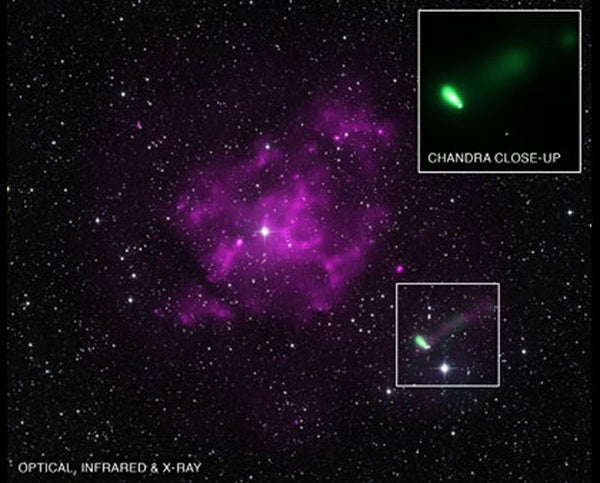The evidence for this potentially record-breaking speed comes, in part, from the features highlighted in this composite image. X-ray observations from Chandra (green) and XMM-Newton (purple) have been combined with infrared data from the 2MASS project and optical data from the Digitized Sky Survey (colored red, green, and blue, but appearing in the image as white).
The large area of diffuse X-rays seen by XMM-Newton was produced when a massive star exploded as a supernova, leaving behind a debris field, or supernova remnant known as SNR MSH 11-16A. Shock waves from the supernova have heated surrounding gas to several million degrees kelvin, causing the remnant to glow brightly in X-rays.
The Chandra image shown in the inset (“Chandra Close-up”) reveals a comet-shaped X-ray source well outside the boundary of the supernova remnant. This source consists of a point-like object with a long tail trailing behind it for about 3 light-years. The bright star nearby and also the one in SNR MSH11-16A are both likely to be foreground stars unrelated to the supernova remnant.
The point-like X-ray source was discovered by the International Gamma-Ray Astrophysics Laboratory (INTEGRAL) and is called IGR J11014-6103 (IGR J11014, for short). It may be a rapidly spinning, super-dense star — known as a “pulsar,” a type of neutron star — that was ejected during the explosion. If so, it is racing away from the center of the supernova remnant at millions of miles per hour.
The favored interpretation for the tail of X-ray emission is that a pulsar wind nebula, that is, a “wind” of high-energy particles produced by the pulsar, has been swept behind a bow shock created by the pulsar’s high speed.
The elongated emission is pointing toward the center of MSH 11-61A where the pulsar would have been formed, supporting the idea that the Chandra image is of a pulsar wind nebula and its bow shock. Another interesting feature of the Chandra image, also seen with the XMM-Newton, is the faint X-ray tail extending to the top-right. The cause of this feature is unknown, but similar tails have been seen from other pulsars that also do not line up with the pulsar’s direction of motion.
Based on earlier observations, astronomers estimate that the age of MSH 11-61A, as it appears in the image, is approximately 15,000 years, and it lies at a distance of about 30,000 light-years away from Earth. Combining these values with the distance that the pulsar has appeared to have traveled from the center of MSH 11-61A, astronomers estimate that IGR J11014 is moving at a speed between 5.4 to 6.5 million mph (8.7 to 10.5 million km/h).
The only other neutron star associated with a supernova remnant that may rival this in speed is the candidate found in the supernova remnant known as G350.1-0.3. The speed of the neutron star candidate in this system is estimated to lie between 3 to 6 million mph (4.8 to 9.7 million km/h).
The high speeds estimated for both IGR J11014 and the neutron star candidate in G350.1-0.3 are preliminary and need to be confirmed. If they are confirmed, explaining the high speeds of the neutron star presents a severe challenge to existing models for supernova explosions.
One important caveat in the conclusion that IGR J11014 may be the fastest moving pulsar is that pulsations have not been detected in it during a search with the Commonwealth Scientific and Industrial Research Organization’s (CSIRO) Parkes radio telescope. This non-detection is not surprising for a pulsar located about 30,000 light-years away.
However, there are other pieces of evidence that support the pulsar interpretation. First, the lack of detection of a counterpart to the X-ray source in optical or infrared images supports the idea that it is a pulsar, since such objects are faint at these wavelengths. Also, there are no apparent differences in the brightness of the source between XMM-Newton observations in 2003 and the Chandra observations in 2011, behavior that is expected if IGR J11014 is a pulsar. Finally, the X-ray spectrum of the source, that is, its signature in energy, is similar to what astronomers expect to see for a pulsar.










